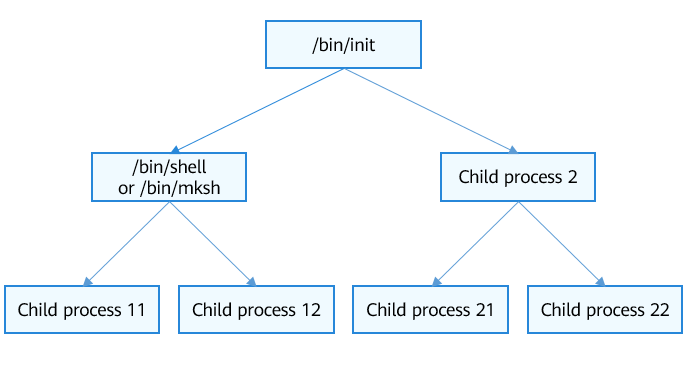Startup in User Space
Startup of the Root Process in User Space
The root process is the first user-space process in the system. The process ID is 1. The root process is the ancestor of all user-space processes.
Startup Process of the Root Process
Use the link script to place the following init startup code to the specified location in the system image.
#define LITE_USER_SEC_ENTRY __attribute__((section(".user.entry")))
LITE_USER_SEC_ENTRY VOID OsUserInit(VOID *args)
{
#ifdef LOSCFG_KERNEL_DYNLOAD
sys_call3(__NR_execve, (UINTPTR)g_initPath, 0, 0);
#endif
while (true) {
}
}
During system startup, OsUserInitProcess is called to start the init process. The process is as follows:
- The kernel calls OsLoadUserInit to load the code.
- A process space is created to start the /bin/init process.
Responsibilities of the Root Process
-
Starts key system programs or services, such as shell.
 NOTE:
In OpenHarmony, the init process reads the /etc/init.cfg file and runs specified commands or starts specified processes based on configurations. For details, see init Module.
NOTE:
In OpenHarmony, the init process reads the /etc/init.cfg file and runs specified commands or starts specified processes based on configurations. For details, see init Module. -
Monitors the process for reclaiming the orphan process and clears the zombie processes in child processes.
Running Programs in User Space
Common compilation modes of user-space programs include:
-
Manual compilation
Example:
clang --target=arm-liteos --sysroot=prebuilts/lite/sysroot -o helloworld helloworld.cBefore running the clang command, install the LLVM compiler. For details, see Installing LLVM.
--target=arm-liteos: specifies that the compilation platform is arm-liteos.
--sysroot=${YOUR_ROOT_PATH}/prebuilts/lite/sysroot: specifies the directory in which you can search for the header file and the dependent standard libraries.
A user-space program can be started in either of the following ways:
-
Run the shell command to start the process.
OHOS $ exec helloworld OHOS $ ./helloworld OHOS $ /bin/helloworld -
Start a new process by calling the POSIX API.
Use the Fork() method to create a process, and call the exec() method to execute a new process.
